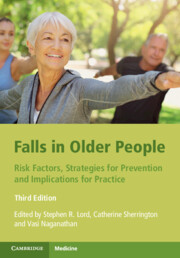Book contents
- Falls in Older People
- Falls in Older People
- Copyright page
- Contents
- Preface
- Contributors
- Part I Epidemiology and Risk Factors for Falls
- 1 Epidemiology of Falls and Fall-Related Injuries
- 2 Postural Stability and Falls
- 3 Gait Characteristics and Falls
- 4 Sensory and Neuromuscular Risk Factors for Falls
- 5 Biomechanics of Balance and Falling
- 6 Foot Problems, Footwear, and Falls
- 7 Brain Function and Falls
- 8 Impaired Cognition and Falls
- 9 The Psychology of Fall Risk: Fear, Anxiety, Depression, and Balance Confidence
- 10 Medical Risk Factors for Falls
- 11 Medications as Risk Factors for Falls
- 12 Environmental Risk Factors for Falls
- 13 Fall Detection and Risk Assessment with New Technologies
- 14 Fall Risk Screening and Assessment
- 15 The Relative Importance of Fall Risk Factors: Analysis and Summary
- Part II Strategies for Prevention
- Part III Implications for Practice
- Index
- References
5 - Biomechanics of Balance and Falling
from Part I - Epidemiology and Risk Factors for Falls
Published online by Cambridge University Press: 04 November 2021
- Falls in Older People
- Falls in Older People
- Copyright page
- Contents
- Preface
- Contributors
- Part I Epidemiology and Risk Factors for Falls
- 1 Epidemiology of Falls and Fall-Related Injuries
- 2 Postural Stability and Falls
- 3 Gait Characteristics and Falls
- 4 Sensory and Neuromuscular Risk Factors for Falls
- 5 Biomechanics of Balance and Falling
- 6 Foot Problems, Footwear, and Falls
- 7 Brain Function and Falls
- 8 Impaired Cognition and Falls
- 9 The Psychology of Fall Risk: Fear, Anxiety, Depression, and Balance Confidence
- 10 Medical Risk Factors for Falls
- 11 Medications as Risk Factors for Falls
- 12 Environmental Risk Factors for Falls
- 13 Fall Detection and Risk Assessment with New Technologies
- 14 Fall Risk Screening and Assessment
- 15 The Relative Importance of Fall Risk Factors: Analysis and Summary
- Part II Strategies for Prevention
- Part III Implications for Practice
- Index
- References
Summary
In biomechanical terms, balance control is the maintenance of the body’s centre of mass (COM: the point around which the body’s mass is equally distributed) within the limits of the base of support (BOS: the area circumscribed by parts of the body that are in contact with a support surface) in the horizontal plane. Simply put, the vertical line of gravity acting through the COM (also termed the centre of gravity), must remain within the BOS for a body to remain in postural equilibrium. Falling is the loss of balance control, i.e. when the vertical projection of the COM moves beyond the BOS. Without a successful balance-correcting response or external intervention to arrest the falling state and regain postural equilibrium, a fall (to the ground or some other lower level) will result. Biomechanical investigations have sought to understand falling by characterizing balance control while standing, walking, during postural transitions, and following unexpected perturbations. These studies complement epidemiological and physiological investigations of fall risk. Findings can help to inform the development of intervention strategies and in turn, biomechanical investigations can enable the evaluation of their effects.
- Type
- Chapter
- Information
- Falls in Older PeopleRisk Factors, Strategies for Prevention and Implications for Practice, pp. 105 - 118Publisher: Cambridge University PressPrint publication year: 2021
References
- 3
- Cited by

